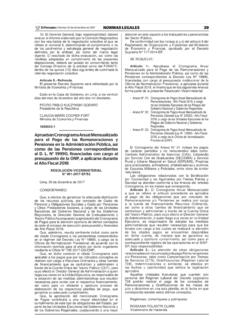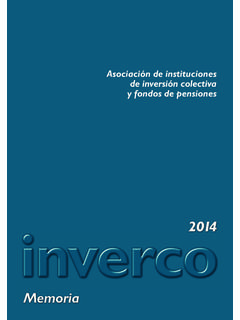Transcription of Pensions at a Glance 2017 - OECD.org
1 Pensions at a Glance 2017 How does SPAIN compare? Key findings Population ageing will accelerate at a very fast pace in Spain, which will have the second highest old-age dependency ratio in the OECD in 2050, after Japan. Future net replacement rates for average-wage full-career workers will be 82%, which is much higher than the OECD average of 63%, even after accounting for the significant pension reform legislated in 2013. The average labour market exit age has stagnated since 2010, widening the gap with the OECD average which has kept increasing. Flexible retirement is limited in Spain by large disincentives to combine work and Pensions and to extend working lives after the retirement age. Overview Replacement rates are high, but combining work and Pensions is unattractive Population ageing will accelerate sharply in Spain.
2 According to UN projections, there will be 76 people above age 65 per 100 people aged 20-64 in 2050 against 30 currently, with only Japan having a (slightly) higher ratio. Projections from Eurostat are lower with a future ratio of 69 instead of 76. Ongoing ageing puts pressure on both the financial sustainability and the income adequacy of pension systems. From 2019, a sustainability factor linking the initial pension benefits to life expectancy at age 67 will apply on top of the indexation mechanism ( ndice de Revalorizaci n) which operates since 2014 to help balance pension finances in the short term. The pension system will deliver relatively high replacement rates for full-career workers, especially for average- and high-wage earners, despite the introduction of the sustainability factor.
3 Net replacement rates from mandatory schemes will be 82% at the average wage compared with 63% in the OECD on average. For high- and low-wage earners, replacement rates will be similar, at 82% and 79%, respectively, against 59% and 73% in the OECD. The statutory retirement age, currently set at years, will gradually increase to 67 by 2027. However, from 2027 people who will have contributed for at least years (against years today) will still be able to retire at age 65 with a full pension , which is therefore the normal retirement age in the OECD baseline case. Despite fast ageing prospects, this future normal retirement age is below the OECD average of years for men and for women, and substantially lower than projected in Denmark (74), Italy (71) and the Netherlands (71).
4 Spain is projected to have the second fastest increase in the so-called old-age dependency ratio, behind only Korea Number of people older than 65 years per 100 people of working-age (20-64), 1975-2050 Spain has high projected replacement rates for full career workers Net pension replacement rate by earnings level and normal retirement age Source: [Figure ]. Source: [Table ]. Contacts: Manuel Flores (+33 1 45 24 99 37; Herv Boulhol (+33 1 45 24 84 58 ; Recent labour market developments may challenge the income adequacy of future retirees. High persistent unemployment weakens the accumulation of pension entitlements for many working-age people. Moreover, many employees have temporary contracts (26% in 2016, which is twice the OECD average), thereby increasing the risk of interrupted careers.))
5 In Spain, individuals with very short careers do not earn pension rights as 15 years of work are required to qualify for a regular pension benefit. However, the accrual rate of 50% for these first 15 years once completed is generous, thereby offering good protection against incomplete careers. Increasing employment rates at older ages remains key given ageing prospects. Effective retirement ages, measured by the average age of labour market exit, were rising before the crisis, but have been stagnant at about 62 years for both men and women, well below the OECD average, of about 65 years for men and 64 for women, and well below the Spanish statutory retirement age. Life expectancy at age 65, instead, has continued to rise sharply.
6 There are severe disincentives to combine work and a full pension in Spain, although some obstacles were reduced with the 2013 reform. It is possible to combine work and Pensions in all OECD countries and in most of them pensioners have no working restrictions after being eligible to a full pension . Only seven countries, including Spain, apply limits to the earnings above which combined pension benefits are reduced. In Spain, the Pensions of individuals who continue working are reduced by 50%, apart from self-employed workers earning less than the minimum wage or hiring at least one worker. Moreover, workers combining work and Pensions do not earn additional pension entitlements although they pay a special solidarity contribution of 8%, which does not apply to those continuing to work and deferring the pension .
7 Further restrictions to access early retirement were introduced since 2013, as well as a higher bonus for the deferral of Pensions . Yet, other incentives to extend working lives can be enhanced. Full career workers deferring their pension while working will receive an increase in Pensions of per year of deferral, which is lower than in most OECD countries having an average of Labour market exit age has stagnated in Spain while remaining life expectancy has continued to rise sharply Spain and OECD average, in years since 2000, Men Source: [Figure ]. Incentives to postpone retirement and continue working for full-career workers in Spain are below the OECD average Average annual impact of working longer and deferring Pensions by three years after the normal retirement age on total annual benefits, full-career average earners Source: [Figure ].
8















